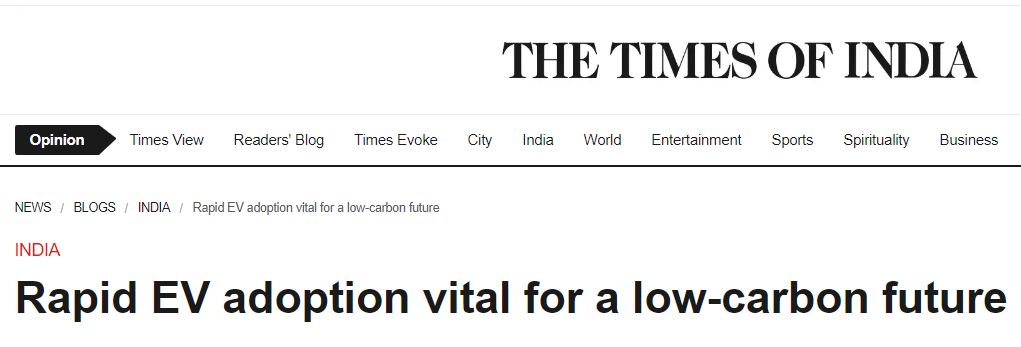The world has reached the cusp of a transition where a rising tide no more lifts all boats but rather floods all houses. Increasing global carbon emissions is a reality we cannot ignore. The Earth’s temperature has risen by 0.14° F (0.08° C) per decade since the late 1800s and is estimated to breach the 1.5°C mark by the early 2030s. Temperatures in India alone have risen by 0.7 °C (1.3 °F) between 1901 and 2018. This scenario makes it imperative to regulate rising global average temperatures immediately to curb carbon emissions.
India is the world’s third-largest emitter of greenhouse gases. Our domestic policies, particularly regarding transport, have the potential to significantly impact global emissions. Globally, transport emissions have increased steadily, accounting for 24% of the direct CO2 emissions from fuel combustion. India’s transport sector with its small vehicle fleet relative to its large population already accounts for 13.5% of the country’s energy-related CO2 emissions. Road transport accounts for 90% of the sector’s final energy consumption and is projected to grow rapidly. There is a growing urgency for stakeholders, including industries and policymakers, to work together on rapid decarbonisation in transport and other sectors if India is to meet the objective of achieving net-zero emissions by 2050.
The majority of India’s transport fleet runs on conventional fuel consumption. Buses and heavy-duty vehicles account for almost 39% of this consumption, while passenger vehicles (cars and utility vehicles) account for about 22%. And these numbers are mounting each day. The volatility in the crude oil pricing, attributed to geopolitical tensions between Russia-Ukraine, only exacerbates the problem. It is critical, therefore, that the sector needs a radical transformation in terms of curbing on-road emissions. Interventions on diesel and petrol-fuelled vehicles must be the first course of action. While alternate fuel technology i.e., hydrogen fuel cell vehicles seems like the ideal substitute for our combustion-engined vehicles, the technologies and processes available in India at present are not as cost-effectively as fossil fuels.
Electrification has emerged as an irrefutable decarbonization option. It not only presents an opportunity to substantially reduce carbon emissions on roads but also save foreign exchange on imported fuel, which can instead be invested in aggressively promoting the setting up of EV infrastructure. India has already started developing a tailored approach to getting EVs off the ground, with several encouraging government schemes like FAME (II), Auto PLI, Green H2 Policy (GHP), and the National H2 Mission (NHM). But as much as we would like to promote EVs as the infallible solution to the problem of carbon emissions, there are both opportunities and challenges when it comes to the electrification of vehicles.
India has emerged as a leader in renewable energy with enormous potential to introduce promising technology and products to enable the mass adoption of electric and new energy vehicles. Seeing the exemplary progress in the new energy vehicles segment, there is now an unprecedented opportunity to achieve 100% electrification in the 2W, 3W & commercial vehicles categories, within a decade.
However, several challenges have to be overcome. For a developing nation like ours, with the need to increase per capita incomes and address other primary issues, transiting to EV technology requires a huge upfront investment. Capital intensity here would be the level of capital required per ton of CO2 abated over the lifetime of a vehicle.
Some of the challenges are also associated with consumer behaviour. In India, purchasing behaviour is economically motivated. In a value-driven market such as India, the high initial costs of EVs, especially in the heavy vehicle segment, is a major roadblock. There is a silver lining, however. The ever-rising fuel prices are stimulating market forces, motivating consumers to buy more fuel-efficient vehicles. Introducing policies like carbon taxes to stimulate the change in consumer behaviour and aggressively promoting the low cost of ownership of EVs, packaged with proactive incentives, subsidies, and tax breaks will enable the consumers to see and adapt the concept of sustainable profitability, catalysing a potent push for EV transition.
The dearth of a sturdy global supply chain of rare-earth metals, lithium, nickel, and cobalt for manufacturing batteries on the scale required for the higher proliferation of EVs is another hindrance to 100% electrification. Nevertheless, infrastructure building in the EV space has been significantly quicker compared to the centuries it took for combustion-engined vehicles. With technological advancements and efficiency improvements, the cost of operating has been substantially driven down, especially in the case of lithium-ion batteries (-84%) and solar (-87%) (TERI, 2020). Electrification of commercial passenger vehicles has picked up in Uttar Pradesh (29%) and Delhi (11.8%) (CEEW). The transition to EVs and hydrogen fuel cells will result in large energy savings.
Such expeditious developments are necessary. Time is of the essence if we wish to reduce carbon emissions to achieve global abatement thresholds as set out in the Paris Agreement. Rapid electrification of the road transport sector, specifically the commercial vehicles segment, is imperative. But automakers and suppliers alone cannot go it alone. There is a need for an integrated approach to addressing the problem at every possible level, which includes making technology choices across sectors. Choices like Hydrogen-based production as a replacement for coal decarbonized or renewable electricity production, and harnessing wind, and solar energy. Despite being a nascent stage of development calling for a major investment, such technologies are expected to be beneficial in the long run, being more sustainable and ensuring a clean, green, sustainable & reliable future.


